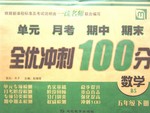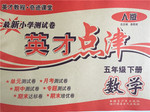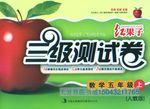
The old sick lady entered the hospital, her two sons.
A .to support B. supporting C. supported by D. having supported
 全优冲刺100分系列答案
全优冲刺100分系列答案 英才点津系列答案
英才点津系列答案 红果子三级测试卷系列答案
红果子三级测试卷系列答案科目:高中英语 来源:2013届湖南省长沙市高考模拟英语试卷(带解析) 题型:阅读理解
There is a saying in French—“Si vieillesse pouvait, si jeunesse savait”—which means roughly “if age had the ability, if youth had the knowledge.” I was reminded of this saying the other day when I saw an interview with a distinguished Asian neurosurgeon(神经外科医生), now retired, about the impact of computer technology on modern surgery.
He was referring to the difficulty people of his age had in using the new techniques, but also to the fact that younger surgeons, who are more comfortable with the technology, lack some of the wisdom of experience.
It struck me that this problem is not just confined(局限于) to specialized fields such as medicine, but is widespread in modern life. There are many areas where the rapid growth of technology has widened the generation gap.
Young people are at ease with modern technology and propose all sorts of ways for using and developing it. But they often lack the experience needed to see further into the future to the possible dangers that a particular development may cause.
Older people see all sorts of difficulties and dangers, but are sometimes ignored, or even accused of being against progress, if they point out potential problems. Equally, they may see potential uses, but not have the technical skills to put them into practice themselves or the trust in the younger generation to do so.
Enthusiasm and inexperience come into conflict with caution and arrogance, usually with unsatisfactory results for both sides.
What is needed is the development of a partnership, based on mutual respect, which can deliver real progress by combining enthusiasm and caution in a constructive way, rather than in conflict with each other. The old need to give the younger generation the time, the resources and, above all, the authority to develop new ideas and use their skills. In exchange, the young need to turn more actively to the older generation to seek their advice and exploit their greater experience of the world in foreseeing and overcoming potential problems.
【小题1】The passage is mainly about ________.
| A.the impact of computer technology on modern surgery |
| B.an interview with a distinguished Asian neurosurgeon |
| C.new generation gap between the old and the young |
| D.a conflict between knowledge and experience |
| A.introduce the topic |
| B.show the difference between French and English |
| C.make readers confused |
| D.prove the writer’s wisdom |
| A.Old people’s enthusiasm in obtaining new technology. |
| B.Old people’s difficulty in using computers. |
| C.Young surgeons’ bad manners in working. |
| D.Young surgeons’ difficulty in getting experience. |
| A.They are happy with modern technology. |
| B.They are easy to learn new techniques. |
| C.They can foresee the future of the young generation. |
| D.They are rich in work experience. |
| A.The young and the old should respect and learn from each other. |
| B.The young should teach the old modern technology. |
| C.The old should maintain their authority in every field. |
| D.The young and the old should work independently. |
查看答案和解析>>
科目:高中英语 来源:2012-2013学年湖南省长沙市高考模拟英语试卷(解析版) 题型:阅读理解
There is a saying in French—“Si vieillesse pouvait, si jeunesse savait”—which means roughly “if age had the ability, if youth had the knowledge.” I was reminded of this saying the other day when I saw an interview with a distinguished Asian neurosurgeon(神经外科医生), now retired, about the impact of computer technology on modern surgery.
He was referring to the difficulty people of his age had in using the new techniques, but also to the fact that younger surgeons, who are more comfortable with the technology, lack some of the wisdom of experience.
It struck me that this problem is not just confined(局限于) to specialized fields such as medicine, but is widespread in modern life. There are many areas where the rapid growth of technology has widened the generation gap.
Young people are at ease with modern technology and propose all sorts of ways for using and developing it. But they often lack the experience needed to see further into the future to the possible dangers that a particular development may cause.
Older people see all sorts of difficulties and dangers, but are sometimes ignored, or even accused of being against progress, if they point out potential problems. Equally, they may see potential uses, but not have the technical skills to put them into practice themselves or the trust in the younger generation to do so.
Enthusiasm and inexperience come into conflict with caution and arrogance, usually with unsatisfactory results for both sides.
What is needed is the development of a partnership, based on mutual respect, which can deliver real progress by combining enthusiasm and caution in a constructive way, rather than in conflict with each other. The old need to give the younger generation the time, the resources and, above all, the authority to develop new ideas and use their skills. In exchange, the young need to turn more actively to the older generation to seek their advice and exploit their greater experience of the world in foreseeing and overcoming potential problems.
1.The passage is mainly about ________.
A.the impact of computer technology on modern surgery
B.an interview with a distinguished Asian neurosurgeon
C.new generation gap between the old and the young
D.a conflict between knowledge and experience
2.The French saying in the first paragraph is used to ________.
A.introduce the topic
B.show the difference between French and English
C.make readers confused
D.prove the writer’s wisdom
3.What did the retired neurosurgeon probably mention in his interview?
A.Old people’s enthusiasm in obtaining new technology.
B.Old people’s difficulty in using computers.
C.Young surgeons’ bad manners in working.
D.Young surgeons’ difficulty in getting experience.
4.In the writer’s view, what advantage do the older generation have?
A.They are happy with modern technology.
B.They are easy to learn new techniques.
C.They can foresee the future of the young generation.
D.They are rich in work experience.
5.What conclusion can be drawn from the last paragraph?
A.The young and the old should respect and learn from each other.
B.The young should teach the old modern technology.
C.The old should maintain their authority in every field.
D.The young and the old should work independently.
查看答案和解析>>
科目:高中英语 来源:20102011学年北京东城区高三下学期第二次联考英语卷 题型:阅读理解
Take a look at the following list of numbers: 4, 8, 5, 3, 7, 9, 6. Read them loud. Now look away and spend 20 seconds memorizing them in order before saying them out loud again. If you speak English, you have about a 50% chance of remembering those perfectly. If you are Chinese, though, you’re almost certain to get it right every time. Why is that? Because we most easily memorize whatever we can say or read within a two-second period. And unlike English, the Chinese language allows them to fit all those seven numbers into two seconds.
That example comes from Stanislas Dahaene’s book The Number Sense. As Dahaene explains: Chinese number words are remarkably brief. Most of them can be spoken out in less than one-quarter of a second (for instance, 4 is “si” and 7 “qi”). Their English pronunciations are longer. The memory gap between English and Chinese apparently is entirely due to this difference in length.
It turns out that there is also a big difference in how number-naming systems in Western and Asian languages are constructed. In English, we say fourteen, sixteen, seventeen, eighteen and nineteen, so one might expect that we would also say oneteen, twoteen, threeteen, and fiveteen. But we don’t. We use a different form: eleven, twelve, thirteen and fifteen. For numbers above 20, we put the “decade” first and the unit number second (twenty-one, twenty-two), while for the teens, we do it the other way around (fourteen, seventeen, eighteen). The number system in English is highly irregular. Not so in China, Japan, and Korea. They have a logical counting system. Eleven is ten-one. Twelve is ten-two. Twenty-four is two-tens-four and so on.
That difference means that Asian children learn to count much faster than American children. Four-year-old Chinese children can count, on average, to 40. American children at that age can count only to 15. By the age of five, in other words, American children are already a year behind their Asian friends in the most fundamental of math skills.
The regularity of their number system also means that Asian children can perform basic functions, such as addition, far more easily. Ask an English-speaking seven-year-old to add thirty-seven plus twenty-two in her head, and she has to change the words to numbers (37+22). Only then can she do the math: 2 plus 7 is 9 and 30 and 20 is 50, which makes 59. Ask an Asian child to add three-tens-seven and two-tens-two, and then the necessary equation(等式) is right there, in the sentence. No number translation is necessary: it’s five-tens-nine.
When it comes to math, in other words, Asians have a built-in advantage. For years, students from China, South Korea, and Japan --- outperformed their Western classmates at mathematics, and the typical assumption is that it has something to do with a kind of Asian talent for math. The differences between the number systems in the East and the West suggest something very different --- that being good at math may also be rooted in a group’s culture.
1.What does the passage mainly talk about?
A. The Asian number-naming system helps grasp advanced math skills better.
B. Western culture fail to provide their children with adequate number knowledge.
C. Children in Western countries have to learn by heart the learning things.
D. Asian children’s advantage in math may be sourced from their culture.
2.What makes a Chinese easier to remember a list of numbers than an American?
A. Their understanding of numbers.
B. Their mother tongue.
C. Their math education.
D. Their different IQ.
3.Asian children can reach answers in basic math functions more quickly because ____________.
A. they pronounce the numbers in a shorter period
B. they practice math from an early age
C. English speaking children translate language into numbers first
D. American children can only count to 15 at the age of four
查看答案和解析>>
科目:高中英语 来源: 题型:阅读理解
查看答案和解析>>
科目:高中英语 来源: 题型:阅读理解
There is a unique place where deserted factories have been transformed into a lively artistic zone – where the city's tradition and heritage (遗产) meet with cutting-edge art and fashion. This is Redtory.
Located at Yuancun Si Heng Lu, not far from the Pearl River of Guangzhou city, Redtory is a creative cultural and industrial zone made up of more than 30 old buildings – mostly red-brick ones. Back in 1956, it used to be the biggest canning factory in China. The factory produced the Can Dace (鲮鱼) with Black Bean Sauce, an iconic food product in the last century, well-known throughout south-east Asia. After the local government's industrial structure reformations, the canning factory moved away and the workshops were left deserted. There was nothing left but memories in well-preserved Soviet-style buildings.
Not long after the noise of the running machines was gone, posters of advertisement and art were found hanging on the wall in the area. To enrich the cultural and artistic life of the people in Guangzhou, the abandoned factories reopened in 2009 – displaying art, fashion and culture of different forms. Redtory is home to more than 40 establishments including art galleries, themed restaurants and design studios. Large international cultural exchange activities, art exhibitions and seminars are often held here, attracting hundreds of thousands of visitors every year. Meanwhile, waste materials have been used wisely instead of being thrown away. For instance, some installations (设施) standing around the area are made up of the rusty machines or components from the old canning factory.
The shabby and nostalgic (怀旧的) appearance combined with fashionable and artistic features makes Redtory uniquely attractive. That may be the reason that Redtory is considered the holy land for young art-lovers in Guangzhou.
Add.: No.128 Yuancun Si Heng Lu, Tianhe District, Guangzhou
Bus: Yuancun Er Heng Rd Stop – 40,44,140,284,293,299,401,504,540,542,583,882;Yuancun Stop Terminal (Meilin Garden) – B11,243;Pazhou Bridge (North) Stop – 137,304,564,B7,B25
Metro: Exit B, Yuancun Station, Line 5
71. The “cutting-edge art and fashion” (Paragraph 1) refers to _____.
A. the deserted factories together with the old culture
B. all that is displayed and going on in Redtory
C. the Soviet-style red-brick buildings
D. the modern world outside Redtory
72. The canning factory was removed from Redtory because _____.
A. the place was too large to manage B. nothing good could be produced there
C. the industrial structure needed reforming D. the place was intended for other purposes
73. Now Redtory has developed into a place for _____.
A. art, fashion and culture B. galleries, restaurants and studios
C. restaurants, exhibitions and seminars D. service and activities
74. What’s special about Redtory?
A. It perfectly combines the old with the new. B. It shows every respect of modern city life.
C. It tells the story of some old buildings D. It shows how the old is replaced by the new.
75. By writing the article, the writer is trying to _____.
A. introduce a modern trend B. report a piece of news
C. make an advertisement D. discuss a hot issue
查看答案和解析>>
湖北省互联网违法和不良信息举报平台 | 网上有害信息举报专区 | 电信诈骗举报专区 | 涉历史虚无主义有害信息举报专区 | 涉企侵权举报专区
违法和不良信息举报电话:027-86699610 举报邮箱:58377363@163.com